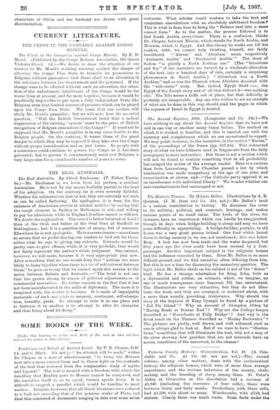SOME BOOKS OF THE WEEK.
[Under this heading we notice such Boa; of the week as have not been reserved for review in other forms.]
Traditions and Beliefs of Ancient Israel. By T. K. Cheyne, D.D. (A. and C. Black. 15s. net.)—" An attempt will be made," writes Dr. Cheyne in a note of advertisement, "to bring the Hebrew text into a more correct form and to throw light on the contents of the text thus restored from the comparative study of myths and legends." The text is treated with a freedom with which the handling that Bentley gave to Horace cannot be compared, and the narrative itself is, so to speak, turned upside down. It is difficult to suggest a parallel which would be familiar to most readers. Imagine, however, that all Greek literature were reduced to a bulk not exceeding that of the genuine works of Plato, and that this consisted of documents ranging in date over some seven
centuries. What scholar would venture to take the text and conjecture emendations with an absolutely unfettered freedom P This is what is done here to bring the "Hebrew text into a more correct form." As to the matter, the process followed is to find North Arabia everywhere. There is a confusion, thinks Dr. Cheque, between Misrim, which stands for North Arabia, and Misraim, which is Egypt. And this theory he works out till his readers, with, we cannot help thinking, himself, are fairly bewildered. "Abram' ' and 'Abraham' mean respectively Aramnite Arabia' and Jeralitne'el Arabia." The story of Sodom "is plainly a North Arabian one." (The "brimstone and fire" of the narrative are turned, by a wholesale alteration of the text, into a hundred days of rain, certainly a surprising phenomenon in North Arabia.) " ..4.bimelech was a North Arabian," and so was the Pharaoh whom Abraham deceived with the " wife-sister " story. But, indeed, Egypt itself—i.e., the Egypt of the Joseph story and of all that follows it—was nothing else. The Nile seems a trifle out of place, but that difficulty is probably not insuperable. Any one who wishes to see an example of what can be done in this way should read the pages in which the sojourn of Israel in Egypt is treated.














































 Previous page
Previous page